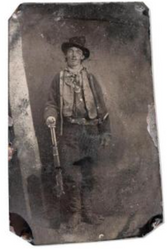Collector’s Corner The Importance of Provenance
Posted by Jim Olson on Aug 27th 2021
One picture of Billy the Kid is worth over 2 million dollars. Another is hardly worth anything. The difference—provenance!
According to the dictionary, the word Provenance is a noun which means: 1. ORIGIN or SOURCE; 2. The history of ownership of a valued object or work of art or literature.
Why is provenance important to collectors? First and foremost, it is the act of being reasonably assured we know the origins of something in a recognized and generally accepted manner. Basically, being comfortable with the authenticity of an item. The more we are assured it is authentic, the more value the marketplace will allow for the item. So authenticity, which of course leads to value, are great reasons provenance is important to collectors.
A fine example of just how important provenance is — is the Billy the Kid photo example. There was an authenticated photo (the one and only) which sold at auction in 2011 for 2.3 million dollars! It had solid provenance. There was a chain of ownership established back to the time it was taken. A copy of the photograph appeared publicly on Jan. 8, 1881, in the Boston Illustrated Police News. Sheriff Pat Garrett used the image twice in his book, “The Authentic Life of Billy the Kid.” The provenance was accepted as iron clad by the collecting world.
On the other hand, there have been a number of other photographs which some claim are also of Billy the Kid. Some, even had pretty convincing circumstantial evidence they were Billy. But just because an old photo looks like him, does not convince the marketplace that it is him. Circumstantial evidence and looking similar to the authenticated photo is a good story, but a long way from convincing the marketplace to shell out big money for it. In this example, solid provenance is about a 2 million dollar difference of the value placed upon the items by the marketplace.
Hallmarked vs. unsigned vintage and antique Native American jewelry is another great example. Most collectors of Native American silver know that much of it was not signed in the early days. As a matter of fact, from the 1970s to current, most Native jewelry is hallmarked, but before that, the opposite was true. Collectors still pay good money for the old, unsigned pieces though. The value is just based on the quality of a piece.
However, there were a few people hallmarking early on. And those pieces now bring a premium because there is a form of provenance. For example, you can take two bracelets that look almost identical and both are quality work. However, one is signed by the Hopi silversmith Morris Robinson (one of the few guys who signed his work) and the other has no hallmarks. The signed one will bring at least twice as much in today’s market. The reason, we know who made it. We can tie it to a certain person in history. The other item may be just as good of quality as far as workmanship goes, but it is speculatory as to who made it. We can say it was most likely Native made based on the construction and style, but there is no where near the degree of certainty you get with the hallmarked piece.
Old bits and spurs are another prime example. There were a lot of old, handmade bits and spurs from the late 1800s and early 1900s that were not hallmarked. However, some were. Even though there are those who can identify (with a fair amount of accuracy) who a particular spur maker was by the style and engraving, items made by guys who were hallmarking back then will realize a premium in today’s marketplace.
G.S. Garcia is a prime example. Most of the items produced in his shop were marked with the hallmark of his shop and they bring top dollar today because we know where they came from. We know he hired the best bit and spur makers available and they put the G.S. Garcia brand on the items. However, there were makers who produced just as nice of items, but unless those items were marked, the ones made and marked by the G.S. Garcia shop will bring more. Much more! The reason? There is provenance (a hallmark) tying the Garcia items to a certain point and place in history. It is not just speculation or an, “it sure looks like so-an-so’s work,” type of situation. The market responds accordingly.
Besides the importance of provenance with regards to who made a particular item, historical event provenance is also very important. An item that can be tied to a certain event in history will always bring more than a like-kind item with no story behind it. But again, provenance is extremely important. Just because it has a good story, or the seller says it was used in a certain historical event, does not necessarily make it more valuable. The more evidence you have tying it to a particular event, the better the marketplace will respond with regards to value. A good example of this is a Colt Single Action Army revolver that had provenance tying it to the battle of the Little Big Horn. One with such provenance sold at auction a few years back for $460,000! Meanwhile, a like-kind Colt SAA with U.S. markings and unknown historical ties will generally bring not more than $10,000 (depending on condition that number can vary greatly).
It is easy to understand the importance of provenance as to the authenticity and value of a piece, but there is another question. Is the provenance real? Any time money is involved, especially when the amounts can be significant, there are people who try to manipulate the system. Fake hallmarks, fake documents, conjured up stories, hearsay, and much more is often passed off as potential provenance. So buyers/collectors should beware and do your due diligence. Educate yourself on the items you intend to collect. When possible, deal with reputable dealers, auctions and sellers. We always advise buyers/collectors to keep as much information with the piece as possible. At the very least, get a written receipt with a basic description and the amount paid. If possible, write down the history that came with it or print out any research you find on the item. It may help tremendously at some point in the future.
Remember, don’t just buy the story, buy the item based on its provenance. With any type of collectible or historical item, the more iron clad the provenance, the more substantial value the marketplace will allow for it.
Jim Olson © 2020
Western Trading Post

